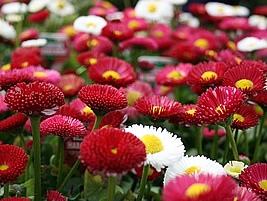The English Daisy (Bellis perennis) is an herbaceous, flowering, and perennial plant, renowned worldwide for its medicinal and ornamental properties. Its botanical name harks back to Latin, where “bellis” means “beautiful” and “perennis” alludes to its perennial nature. Native to Europe and the Mediterranean region, this species has adapted to various habitats, particularly in meadows and open fields. Historically, the English Daisy symbolized innocence and purity in Ancient Rome, often associated with legends and mystical rituals.
Its leaves are green, spatulate, fleshy, with crenate or serrate margins, pubescent, and arranged in a basal rosette. The inflorescences rise above the foliage, are of the capitulum type, with petals in shades of pink, white, or red, and a bright yellow center. What appears to be a single flower is, in fact, an inflorescence, i.e., a cluster of many small flowers or florets; the outer ones are ligulate and female, while the central ones are tubular and hermaphroditic. The flowering of the English Daisy occurs throughout the year, depending on the planting season, with a notable peak in spring. The fruits are dry, ovate, pubescent, and indehiscent, of the cypsela type. There are also varieties with single or double corolla inflorescences.
This cheerful and delicate daisy, resembling a pom-pom in double varieties, is commonly used in borders and mass plantings, as well as in pots and window boxes. In landscaping, the English Daisy is valued for its ability to attract pollinators such as bees and butterflies, and it is excellent for ground cover, forming beautiful flowering clumps. Its simple beauty adapts well to rock gardens or country-inspired designs. It can also be used in mixed beds with other field flowers, as well as colorful borders along pathways.
Its flowers have strong stems and are quite durable, making them suitable as cut flowers, in the composition of arrangements and bouquets. In floral arrangements, the English Daisy is appreciated for its simplicity and elegance. Often used in weddings and formal events, it symbolizes constant love and innocence. The English Daisy also plays an important role in phytotherapy, where it is used to treat skin and respiratory conditions, due to its anti-inflammatory and expectorant properties. Versatile, the English Daisy is also edible and medicinal, widely used in the form of poultices and infusions from the flowers and leaves.
The English Daisy should be grown in full sun or partial shade, in fertile, well-drained soil, enriched with organic matter, and watered regularly. It thrives in the cool climate of subtropical to temperate regions. However, it does not tolerate severe frosts and should be protected with straw or other mulching to maintain stable temperatures. Although perennial, it is cultivated as an annual and at most biennial, as it loses beauty and vigor over time. Propagation is through seeds and division of stolons. Its cultivation requirements include regular pruning to encourage flowering and prevent rot at the base, as well as pest control against aphids and fungal diseases, common in humid environments.


